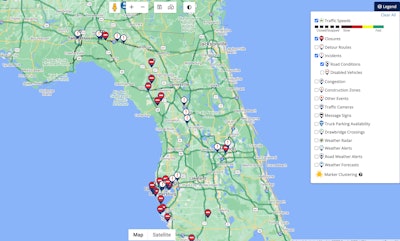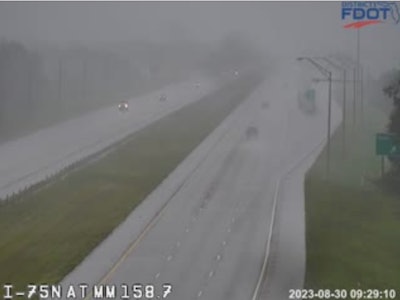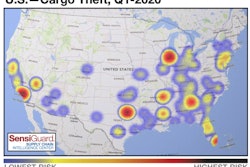
Hurricane Idalia made landfall this morning as a powerful Category 3 hurricane roughly 30 miles southeast of Tallahassee leading to the closure of one of the nation’s busiest ports along with roads and highways.
The National Hurricane Center’s latest track shows the storm traveling north-northeast at 18 mph into southeast Georgia towards the Port of Savannah which shut down late Tuesday.
Port officials are planning to reopen Thursday to resume business at the bustling Atlantic port which saw 447,587 TEUs or twenty-foot equivalent containers for July, a 17% increase over June. Other ports that have closed include the Port of Jacksonville, Fla., Port Canaveral, and the Port of Charleston, S.C.
 A traffic cam from the Florida Department of Transportation shows Interstate 75 on Wednesday morning at 9:29 a.m. EST not long after Hurricane Idalia made landfall.FDOT
A traffic cam from the Florida Department of Transportation shows Interstate 75 on Wednesday morning at 9:29 a.m. EST not long after Hurricane Idalia made landfall.FDOT
Under the direction of Florida Governor Ron DeSantis tolls have been suspended along the west coast of Florida for 7 days. Facilities include the I-4 Connector, Selmon Expressway (S.R. 618), Veterans Expressway (S.R. 589), Suncoast Parkway (S.R. 589), Turnpike Mainline (I-75 to I-4), Pinellas Bayway (S.R. 679), Sunshine Skyway Bridge (U.S. 19).
According to Gas Buddy's top analyst Patrick De Haan the storm has led to some fuel supply disruptions.
"Seeing a low level of outages, under 7% for all cities in Florida, and virtually no impact on prices," De Haan said. "We probably won't see much change in price and will take another day or two once the storm clears Florida to potentially see outage numbers edge higher, but it seems the situation shouldn't get much worse."
Carries who have weathered prior storms and other disruptive events like COVID-19 offered tips on how to recover and forge ahead during CCJ‘s online Symposium, Upshift.
The devastation COVID-19 left behind may not be as obvious as the visible damage following a hurricane, wildfire or flood, but make no mistake, the pandemic turned out to be a natural disaster of sorts.
Panelists for “Disaster Recovery: Lessons Learned in the Bounce Back” and included Florida Rock and Tank Lines Vice President of Safety and Risk Management Jim Anderson; Brian Fielkow, CEO of Jetco Delivery; and Liquid Trucking’s Evan and Josh Schmidt.
Plattsmouth, Nebraska, suffered a generational flood in early 2019 and “while it’s near the river, it’s never been wet in the last 100 years of recorded history,” said Josh Schmidt. “You don’t ever dream of this kind of thing happening to you.”
Its terminal rendered uninhabitable by flood waters, Liquid Trucking was able to move its operation to a nearby car dealership to maintain operation while Evan Schmidt worked to keep the company’s technology infrastructure above water.
“We’d been preparing in all the wrong places,” Josh Schmidt added. “It goes to show you that you can be as prepared as you want but when disaster strikes, it can literally be anything.”
Fielkow, whose Houston-based Jetco Delivery went through hurricanes Ike and Harvey in recent years, said the most effective way to navigate a crisis is to work with one foot directly in the event itself while also focusing on tomorrow.
“When we went through Harvey, we looked at not only how we were going to survive but also how we were going to thrive,” he said. “We’re going through the same thing now with COVID-19. It’s a very painful process for all of us.”
Fielkow said it’s important to access what the company is learning via its disaster response and pull them forward to be stronger and better. The most important thing to understand is that outcomes are generally tied to leadership ability, he added.
“The first thing I learned in Harvey is that I couldn’t lead anybody if I wasn’t ready,” he said.
Having a business continuity plan is a key part of being ready, said Anderson, whose company was impacted by Hurricane Michael in 2018.
“Over the years, we have worked to have a standardized plan,” he said, noting the plan is reviewed every year in May. “Doing that, you’re able to double check and make sure that everything that needs to be thought about has been considered.”
Anderson said his company’s continuity plan included a response for a pandemic, “but I don’t think we ever could have imagined that we would be faced with the situation we’ve had to work through.”
Having never been through an event can make it difficult to plan a response, Anderson said. He recommends that fleets have a pandemic action plan “as a baseline to work from helped us have the fundamental structure in place as [COVID-19] started to ramp up,” he said. “That was a really good thing for us to have in place … to manage through this with the least disruption as possible.”
The extended nature of the current disruption caught the company by surprise.
“Typically the things that you would have in a hurricane are of a shorter duration that what we’ve experienced here with a pandemic,” he said. “That’s probably the one thing that we’d put more thought into going forward is having extended disruption to the business operation.”
Liquid Trucking integrated what it learned from the company’s flood response into an updated disaster preparedness plan, which Josh Schmidt said made the transition to working from home during the COVID outbreak much easier.
“What we learned in Harvey, quite quickly, was that our employees were more than capable of working remotely. Because we had a plan in place to basically shift our phones, computers [and] everything remotely, it worked,” said Fielkow. “We were kind of able to pick up on that playbook to use that.”
“I had no idea going into COVID-19 that we’d be working remotely for as long as I think we’re going to,” he continued. “But the point is, we haven’t really missed a beat and the fact that we’re able to do this so well comes out of learning in Harvey how to work remotely. And that’s all documented in the business continuity plan, making sure our IT is in the cloud … employee assistance plans. There were parts of the plan that were applicable to COVID-19.”
What Jetco has learned through COVID, Fielkow said, will also be folded into the company’s preparedness plan.
“We’re getting smarter in a whole new area,” he said. “It’s iterative. Every challenge leads to new learnings.”
Similarly, Liquid Trucking will include its coronavirus response in its updated plan.
“I know it seems reactionary, but how do you plan for some of this stuff?” Josh Schmidt said. “And this is going to help our flood plan, too. We’ve got people that have been working from home. We’ve made some adjustments. We’ve had some good ideas from employees. Whatever happens next, I think we’re going to be that much more versatile.”
A replay of the panel discussion, titled “Disaster Recovery: Lessons Learned in the Bounce Back from Near-Ruin,” will be available for download next week at the following link: www.ccjsymposium.com/downloads.










